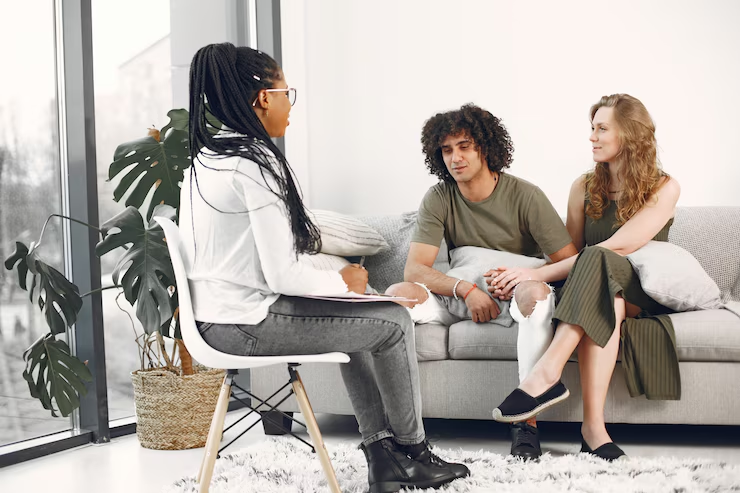The Statistics We Don’t Talk About.
Recent studies have revealed that while interracial relationships are steadily increasing worldwide, many couples still face significant emotional, societal, and psychological obstacles. In fact, data from multiple relationship satisfaction surveys show that interracial couples report experiencing more stress due to external judgment, family disapproval, and cultural misunderstandings.
According to a Pew Research Center report, nearly 40% of people in such relationships said they encountered opposition from close family or community members. These aren’t just numbers. They reflect deeply personal experiences. Mine is one of them.
I never expected love to be complicated. I never expected identity and connection to become a battlefield. I thought that if two people truly cared for each other, then that would be enough. But I was wrong.
When Love Feels Like a Risk.
From the beginning, it felt like walking a tightrope. Our bond was strong, but everything outside of us made it feel fragile. The whispers behind our backs. The awkward silences from friends. The family dinners that felt more like interrogation rooms.
I remember the first time I introduced my partner to my inner circle. Their smiles were tight. Their questions were laced with judgment. I could feel the heat rise in my chest as my partner answered politely while squeezing my hand under the table.

That night, we sat in the car in silence. The city lights blurred through the windshield. I could feel the tears welling up but I didn’t let them fall. I just said, “Maybe it’ll get better.” But deep down, I wasn’t sure.
I felt torn between the people I had known my whole life and the person who was becoming my whole world. That tension began to eat away at me. I started questioning everything.
Was I strong enough for this? Was love really enough to carry the weight of disapproval and misunderstanding?
Emotional Exhaustion and Identity Confusion.
Over time, it wasn’t just the outside world that became difficult. It was the inner turmoil. I started doubting my own identity. I felt like I was constantly code-switching—being one version of myself with my partner and another with my family.
It felt like there was no place where I could just be me. I was losing parts of myself to fit into everyone’s expectations.
I’d lie awake at night staring at the ceiling wondering if love should really feel this hard. I found myself becoming distant. My partner noticed. The connection that once felt effortless now required constant reassurance. I’d apologize for things that weren’t my fault. I’d stay silent in situations where I should have spoken up.
There was a time I started believing maybe I wasn’t meant for love. Not this kind of love anyway. I felt isolated. Misunderstood. Disconnected from everything and everyone. Even my own reflection in the mirror started to feel like a stranger.
I remember breaking down one evening while folding laundry. It was such a simple task, but the weight of everything came crashing down. I sat on the floor holding a shirt that still smelled like my partner’s cologne and I sobbed uncontrollably. That was the moment I realized I was breaking in places I hadn’t even known could crack.
The Financial Strain of Relationship Stress.
What many people don’t realize is that emotional stress doesn’t stay confined to the heart. It seeps into everything. I started struggling at work. My productivity dropped. I found it hard to focus during meetings. Deadlines started slipping through my fingers. I was afraid to talk about it because I didn’t want to seem weak or distracted.

Eventually, I started missing opportunities. Promotions that should’ve been mine went to someone else. I was spending so much emotional energy just trying to keep my relationship afloat and protect it from judgment that I had nothing left for my career. It was a dangerous cycle. My paycheck shrank and so did my self-worth.
I began searching online for solutions—relationship communication skills, couples therapy, identity conflict in dating, how to deal with unsupportive family—and I stumbled upon thousands of others facing the same pain. It was oddly comforting and deeply sad. So many of us were struggling in silence.
I wanted help. I needed help. But I didn’t know where to turn.
Taking the First Step Toward Healing.
The moment I admitted to myself that I needed help was both terrifying and liberating. For so long, I had internalized the shame and struggle. I believed that asking for help meant I was weak or that my relationship had failed. But the truth was that pretending everything was fine was slowly destroying me.
I began my healing with one small but powerful step: journaling. Each night, I wrote down what I was feeling. I stopped censoring myself. I wrote about the moments I felt like I didn’t belong.
I wrote about the fear of losing my relationship. I wrote about the overwhelming anxiety that came with the constant judgment from people around me. This process of emotional release helped me clear my mind and focus on what I truly needed.
I also started practicing self-care intentionally. I scheduled therapy sessions with a counselor who specialized in relationship conflict and identity trauma. At first, I was hesitant. I didn’t think I had the energy for more uncomfortable conversations. But therapy gave me something I hadn’t felt in a long time—emotional safety.
Rebuilding Trust in Love and in Myself.
During one of my sessions, I remember saying, “I don’t know who I am anymore.” That single sentence opened the door to everything. We explored the layers of my identity, the things I’d been taught, the values I had absorbed from my family, and how all of that clashed with the love I was trying to build.
My therapist helped me see that this wasn’t about choosing one world over the other. It was about integrating my full self into the life I wanted to live.
That insight gave me the courage to sit down with my partner and have real conversations. For the first time, I didn’t hold back. I told them about the guilt I felt. The shame. The confusion. I admitted the truth I had been too afraid to speak—I was scared we wouldn’t make it.

To my surprise, they didn’t back away. They leaned in. They cried with me. They opened up about their own struggles and fears. That conversation didn’t fix everything overnight, but it marked the beginning of our reconnection.
We started reading relationship growth resources together. We watched communication strategy videos. We practiced empathy in the way we spoke to each other. Instead of avoiding topics that triggered pain, we addressed them gently but directly.
This shift in our dynamic helped rebuild trust and emotional intimacy. Slowly, the invisible wall that had grown between us began to crumble. We found laughter again. We found safety in our silence. We no longer needed to prove our love to anyone outside of us. We just had to live it fully.
Finding the Right Support Systems.
Another critical part of my journey was building a new kind of community. I knew I couldn’t keep trying to make everyone in my life understand or approve of my relationship. So I stopped wasting energy on trying to be accepted in places that only offered resistance.
Instead, I sought support networks online and offline that focused on couples navigating emotional barriers, relationship counseling insights, and personal development for love.
These were people who had been in the trenches of identity-based relationship challenges. Their stories made me feel less alone. Their advice helped me make practical changes in how I handled judgment and emotional burnout.
I also started consuming content that uplifted and educated. I followed relationship advice podcasts, read articles on emotional healing in couples, and learned the psychology of dating success and acceptance.
These resources helped shift my mindset. I started to believe I was worthy of love that didn’t hurt. That I could set boundaries without guilt. That I could have a relationship that honored both my individuality and our partnership.
Breaking Free from Emotional Dependence.
One of the hardest things I had to unlearn was emotional dependence. For a long time, I tied my self-worth to how others viewed my relationship. If someone didn’t approve, it felt like a personal failure. I would spiral into self-doubt and overanalyze every part of our connection.
Through introspection and guidance, I realized this was rooted in unresolved trauma and insecurity. I began working on building emotional independence. I stopped outsourcing my happiness to others.
I focused on strengthening my confidence and clarity. This didn’t mean I stopped caring what my partner felt. It just meant that my entire identity no longer hinged on validation from the outside.

I invested in high-quality relationship therapy sessions and personal coaching focused on self-empowerment. These services weren’t cheap, but they were life-changing. The return on investment was emotional freedom. For the first time in a long time, I didn’t feel like I was drowning.
We started setting shared goals as a couple. We planned for the future without fear. We built financial wellness plans together. We explored shared hobbies. We created relationship rituals that grounded us. It was no longer about surviving. It was about thriving.
What Changed Everything.
The turning point came when I realized I had finally stopped apologizing for loving who I loved. I stopped trying to explain or defend our connection. I stopped feeling ashamed of the challenges we had faced. We had walked through fire and come out stronger. And it wasn’t because we were lucky. It was because we did the work.
Today, we laugh more. We argue less. We listen better. We still face judgment sometimes, but we face it together. Our relationship is no longer defined by struggle. It is defined by choice. Every single day, we choose each other.
And while therapy and support groups played a role in our healing, there was one powerful resource that helped me understand the depth of what we were facing and how to rise above it.
A Resource That Transformed My Life.
Everything I learned about overcoming identity conflict in relationships, building emotional security, and navigating cultural misunderstanding came together through one powerful book. It’s called Bridging the Divide: Love, Identity, and Building Interracial Relationships.
This isn’t just any low-content book. The content and expert advice inside make it one of the most valuable and top-tier resources I’ve ever come across.
The book helped me unpack years of emotional pain and taught me how to rebuild not just my relationship, but my sense of self. It offered structured steps, grounded in real experience, with practical solutions that worked.
Because of this book, I no longer question whether I belong in the love I have. I know I do. I live it every day. If you’re struggling the way I was, do yourself a favor—grab a digital copy of Bridging the Divide: Love, Identity, and Building Interracial Relationships. It’s available right now at Libriffy.com. This book changed my life in a way that nothing else could. And I believe it can change yours too.
Story By: Hennas Melinda.
Interviewer: Evelyn Kay For Fact After Fact Magazine.
I am an accomplished author and journalist at Fact Finders Company . With a passion for research and a talent for writing, I have contributed to numerous non-fiction titles that explore a wide range of topics, from current events, politics and history to science and technology. My work has been widely praised for its accuracy, clarity, and engaging style. Nice Reading here at Fact After Fact.








